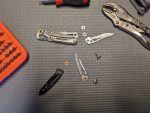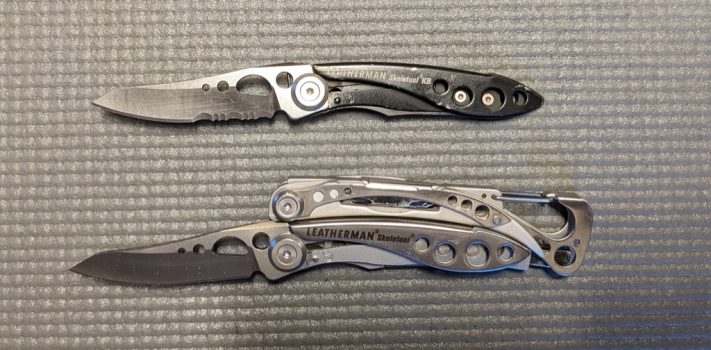My favorite everyday carry (EDC) knife is actually a multi-tool: the Leatherman Skeletool. I like the convenience of carrying a combination tool that includes a pair of pliers and several screwdrivers with, as well as a blade.
I first acquired the Skeletool in 2021, and reviewed it in an article published in SurvivalBlog at that time.
I have never been fully satisfied with the part-plain/part-serrated combi blade that came with my Skeletool. This is a matter of personal preference, but I like fully plain blades on my EDC knives more than combi blades. I know that there are some situations in which a serrated blade is helpful. But in my experience it seems that there are a hundred or more situations where a plain blade works best versus the rare situation where a serrated blade would be more helpful.
The Search
Based on my preference for fully plain blades, I recently started looking to see if I could find a fully plain replacement blade for my Skeletool. I found several on the well-known eBay Internet auction website, but they were quite expensive. The best deal I could find was $39.99 for a used blade. That price seemed quite steep for a 2.6-inch blade in 420HC stainless.
Further research revealed that the Skeletool KB model knife uses the same blade profile as the Skeletool multi-tool, and is readily available in both combi blade and fully plain blade versions.
I found a used fully plain blade version of the Skeletool KB knife being auctioned on eBay, and bid on it. I won the auction with a bid of $19.99. So for half of the price of a blade alone, I was able to buy an entire knife. This would allow me to switch the blades on the two tools, and still have two functioning items.
Overview
 The blades of the Leatherman Skeletool multi-tool and the Leatherman Skeletool KB knife are fully compatible for a blade interchange. For multi-tool owners who prefer a plain-edged blade, switching blades with a plain-edged KB knife may be an economical way of updating their multi-tool. Skeletool owners should be aware, however, that making this modification may void the warranties on both of the tools.
The blades of the Leatherman Skeletool multi-tool and the Leatherman Skeletool KB knife are fully compatible for a blade interchange. For multi-tool owners who prefer a plain-edged blade, switching blades with a plain-edged KB knife may be an economical way of updating their multi-tool. Skeletool owners should be aware, however, that making this modification may void the warranties on both of the tools.
Opening the Package
![]()
 In the pictures on eBay, the blade appeared to be somewhat stained with corrosion, and the handle appeared somewhat battered. Those impressions were confirmed upon opening the package. A quick scrub with an SOS scouring pad successfully removed all corrosion stains from the blade. There was not much I could do about the battered handle.
In the pictures on eBay, the blade appeared to be somewhat stained with corrosion, and the handle appeared somewhat battered. Those impressions were confirmed upon opening the package. A quick scrub with an SOS scouring pad successfully removed all corrosion stains from the blade. There was not much I could do about the battered handle.
As would be expected with a knife that showed signs of neglect, the blade was not especially sharp. Fortunately, although edge retention with 420HC stainless is nothing to brag about, it does sharpen easily. A short session with the sharpener soon had it shaving sharp.
The small size of the Skeletool KB handle makes the knife somewhat difficult to open one-handed. There is just not that much handle for the rest of the hand to grip while the thumb is working to deploy the blade.
I was surprised to find that the end of the pocket clip was broken off from the KB knife. I had not noticed this on eBay, although it was clearly shown in the pictures accompanying the description. This was a secondary concern, since I was primarily interested in the blade, but it was a disappointment nonetheless. I did not find it convenient to carry the KB knife without a functioning pocket clip.
Switching the Blades
I put my gun cleaning mat on the kitchen table, and collected some tools for a session of musical knife blades. Those tools included a Torx wrench set, a set of 1/4 inch bits, a screwdriver that uses 1/4 inch bits, and a pair of vise-grip pliers.
 I put a T8 bit into the jaws of the vise-grip pliers, so that the bit was facing upward while the pliers were lying flat on the table. I put a second T8 bit into the screwdriver. I then positioned the Skeletool multi-tool so that the bit in the vise-grip was inserted into the bottom of the pivot screw for the blade. Next, I inserted the bit on the screwdriver into the top of the pivot screw. I then unscrewed and removed the pivot screw, and removed the blade and associated washers from the Skeletool multi-tool.
I put a T8 bit into the jaws of the vise-grip pliers, so that the bit was facing upward while the pliers were lying flat on the table. I put a second T8 bit into the screwdriver. I then positioned the Skeletool multi-tool so that the bit in the vise-grip was inserted into the bottom of the pivot screw for the blade. Next, I inserted the bit on the screwdriver into the top of the pivot screw. I then unscrewed and removed the pivot screw, and removed the blade and associated washers from the Skeletool multi-tool.
The pivot point retention nut was attached to the frame of the Skeletool KB knife, so I needed to use only the screwdriver to remove the pivot screw from the knife.
When both blades were removed, I scrubbed each with an SOS scouring pad, rinsed and dried them, and then applied a thin film of Breakfree CLP lubricant.
I then reassembled the two items, with the fully plain edge blade in the Skeletool multi-tool, and the combi blade in the Skeletool KB knife.
Reassembly of the multi-tool was complicated by the necessity of getting all of the holes to line up properly. The tolerances are pretty tight, and some of the parts are under spring tension, so it takes a little finagling to get everything in exactly the right place. After a number of unsuccessful attempts, I finally managed to get all the holes lined up and the pivot screw into place.
When the multi-tool was fully reassembled, I tested both the blade and pliers for function. Blade deployment felt a little tight at first, so I played around some with exactly how much I should tighten the pivot screw. There was a fine line between too tight and too loose. After a number of tiny adjustments, I finally got it just right, just like Goldilocks eating Baby Bear’s porridge.
Reassembly of the Leatherman KB knife was much simpler. After some minor adjustment of pivot screw tension, it worked quite well.
Testing
After switching to a plain-edge blade, I carried the Skeletol multi-tool daily for more than a week to get a sense of how the new blade functioned. I used it for a number of tasks, which included the following:
∙ Cutting plastic jugs for my wife, “Kari”, to use for her winter sowing.
∙ Cutting open a package of hot dogs to be roasted over our fire pit.
∙ Cutting seams in a cardboard box, so that it could be ripped up and used to start another fire in the fire pit. Kari and I had cut a dead tree by the parking lot at our church, and we needed to burn up some of the brush.
∙ Cutting open a package containing a steak, so that it could be grilled.
∙ Cutting the steak on the grill to make sure that it was done.
∙ Opening various boxes and packages.
∙ Cutting away a broken piece of plastic that was blocking the bolt hole on a wheel barrow I was repairing.
The plain-edged blade did an excellent job in all of these tasks and more. I am very happy with the change. The new fully plain blade seems to fit my pattern of knife use much better than the old combi blade.
420HC Steel
420HC is a relatively inexpensive stainless steel that is used in many budget knives. It is manufactured by the American company Latrobe. The steel is easy to hone, offers mediocre edge retention, and resists corrosion well. It is composed of 85.44% iron, 13% chromium, 0.46% carbon, 0.4% manganese, 0.4% silicon, and 0.3% vanadium.
Multi-Tool History
Multi-tools date back to at least the third century AD. A Roman eating utensil dating to that era incorporated a knife, fork, spoon, pick, spike, and spatula.
In the centuries that followed, inventors designed a host of other multi-tools that included such variations as the hammer/plier/axe, the crowbar/plier, the plier/wrench, and the knife/wrench.
In 1889 the Swiss Army contracted with the supplier of their standard issue folding knife to add a screwdriver, can opener, and reamer to the knife. The ever-popular Swiss Army Knife was born.
In 1975 Tim Leatherman and his wife, Chau, took a budget tour of Europe. Things kept breaking, and Leatherman kept wishing he had a pair of pliers to help fix them. Over the course of the next three years after their return to the United States, Leatherman built a prototype for a new multi-tool built around an ingeniously designed pair of pliers, and patented it. But he could not find a manufacturer to make the new product. Finally, in 1983, Leatherman partnered with his college buddy, Steve Berliner, to begin production of the new multi-tool. Cabela’s ordered the first 500 units. In the ensuing decades, a host of imitators and/or improvers have drawn inspiration from Leatherman’s groundbreaking design.
Conclusions
For Leatherman Skeletool multi-tool owners who prefer a plain-edged blade, switching blades with a plain edged Skeletool KB knife may be an economical way of making that change. The blades of the two items are fully compatible, and the switch is not at all difficult. Similarly, a broken blade could be replaced, using the same method that I described. Skeletool owners should be aware, however, that making this modification may void the warranties on the tools.
Disclaimer
I did not receive any financial or other inducement to mention any vendor, product, or service in this article.










